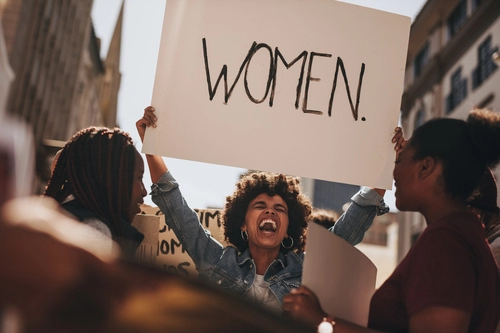1. Select a discrete app icon.

notes
VAWA Should Fund More Housing, Not More Policing
The Violence Against Women Act promotes a police response, which can sometimes mean victims wind up behind bars
- Aug 17, 2022

President Biden recently reauthorized the Violence Against Women Act (VAWA), an act that was first passed in 1994 and was intended to bring domestic violence out of the shadows of closed-door family discussions and into the realm of public accountability. The most recent reauthorization has, among many other provisions, renewed grant funding for law enforcement programs to address domestic violence. Police funding increased prior to this reauthorization, but more police funding is not the solution.
On the surface, the reauthorization of VAWA and claims that it continues to protect women against domestic violence sounds noble, but the truth is that the 2022 version of VAWA perpetuates problematic police responses rooted in racism and sexism.
The Incarceration of Women Continues the Domestic Abuse Cycle
First, victims of domestic violence are sometimes incarcerated as a consequence of dual arrests—law enforcement arresting survivors of abuse as well as the abusers —and women of color are more likely to experience dual arrest than white women. The practice of dual arrest ignores the reality that abuse often plays a role in perpetuating criminal activity, forcing women to commit crimes as part of the abuse cycle. The ACLU estimates that 60 percent to 94 percent of the female prison population have a history of physical or sexual abuse prior to incarceration. Additionally, Black women who kill an abusive partner have double the rate of conviction in comparison to White women. A stark example of this is the case of Marissa Alexander, a Black woman who was sentenced to 20 years after firing a non-lethal warning shot in response to being attacked by her estranged husband, inspiring the organization Survived and Punished and the hashtag #FreeThemAll .
Tragically, the incarceration of women is often a continuation of the abuse cycle. Domestic violence turns into state-sponsored violence in the form of hundreds of incidents of sexual misconduct by correctional staff. In particular, those who are women of color as well as those who are queer, trans and gender-nonconforming people are more likely to bear the brunt of this state-funded violence.
Some proponents of the renewed VAWA bill point to much-needed community funding as a positive sign of progress, yet closer examination of the funding breakdown shows that police funding exceeds community funding by over 30 times: $5 million is allotted for community-based organizations while $185 million is for law enforcement.
What Helps Abuse Victims More: Policing or Housing?
As a psychologist who works with those who have experienced domestic violence and as someone who witnessed domestic violence in my own household growing up, I say we need to fund something far more impactful than policing: universal, high-quality, permanent housing.
Housing instability is both a contributing factor to and a consequence of experiencing domestic violence. Many women who have been abused report arguments about financial stress as a precursor to experiencing violence. Most of the violence which I witnessed in my own home began as conflicts related to the financial stress and occasional homelessness we experienced. COVID-19 also is an example of this, with the associated financial stress of the pandemic increasing the likelihood of abuse of women three-fold.
The National Network to End Domestic Violence reports that many women cite housing instability and finances as a primary barrier to leaving an abusive partner. According to ACLU, “When women flee domestic abuse, they are often forced to leave their homes, with nowhere else to turn.” Research also shows that domestic violence is often a precursor to housing instability and homelessness for women and children, especially for women of color, as they experience the intersection of gendered and racialized societal inequities.
Over one-third of domestic violence survivors experience homelessness after leaving an abusive relationship, and there is already a national housing crisis in the United States. The racial homeownership gap has actually increased since the 1960s at the height of the Civil Rights Movement, and with the current domestic violence crisis increasing homelessness, funding for high quality, permanent stable housing is more important than ever.
Transitional Housing Isn’t Enough for Domestic Violence Survivors
Certainly, transitional housing and shelters may have temporarily stabilized my family and others fleeing domestic violence. But what about after? Transitional housing’s effectiveness is temporary, and sometimes detrimental to children’s mental health. The U.S. Department of Housing and Urban Development (HUD) recently published one of its most robust studies showing that the most effective intervention for families in need of housing stability is long-term housing, which can lead to benefits in psychological well-being for adults and children. The U.S. Department of Health and Human Services has also noted that long-term housing is a necessity for survivors and their children.
Studies have long shown that high-quality housing can lead to beneficial impacts such as a positive sense of self, stability, and security, with survivors of violence tending to experience improvements in their physical and mental health. A large study of almost 2,000 children shows that housing assistance policies that support high-quality, stable, and affordable housing can lead to positive mental health outcomes for children and adolescents. Children who experience high-quality housing show more psychological resilience and better task persistence.
Donate and change a life
Your support gives hope and help to victims of domestic violence every day.
If my family had been offered permanent and high-quality housing, perhaps decades of suffering would have been avoided, and perhaps my siblings and I would not be paying the psychological costs of depression, anxiety, and trauma symptoms from our nation’s housing crisis. So, to protect women in domestic violence situations, stop funding more policing and fund more housing.
This article is part of #YourVoice, an ongoing column published on this website by individual contributors in their own personal capacity and that involves the opinions, recollections and/or information provided by such contributors, and which does not necessarily reflect the official policy or position of this website. Aileen Fullchange, PhD is a Public Voices Fellow of the OpEd Project and a licensed Taiwanese-American psychologist who serves diverse teens, individuals, couples, and families on Caddo, Witchta and Comanche land in Dallas, Texas. She works at the crossroads of psychological well-being, education, and equity as a clinician and speaker.
Photo by Scott Rodgerson on Unsplash.
Looking for someone to speak with? Enter your location to find phone numbers for domestic violence experts in your area.
Have a question about domestic violence? Type your question below to find answers.







